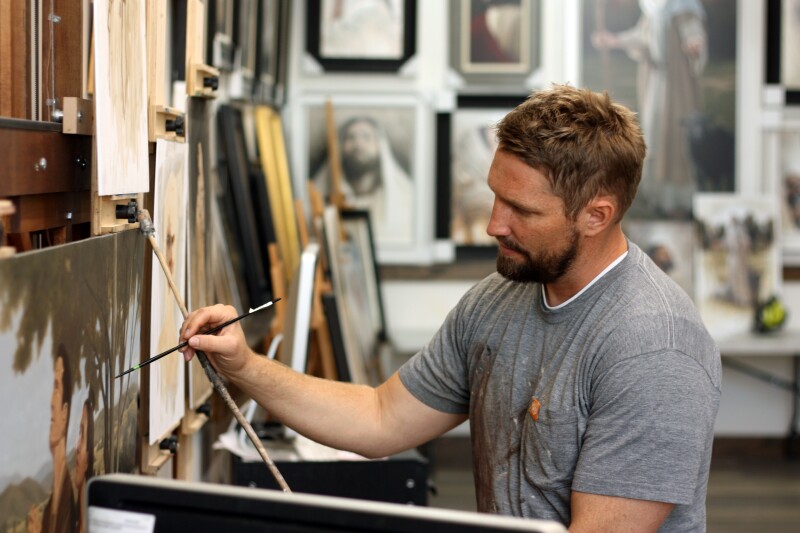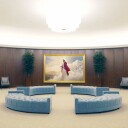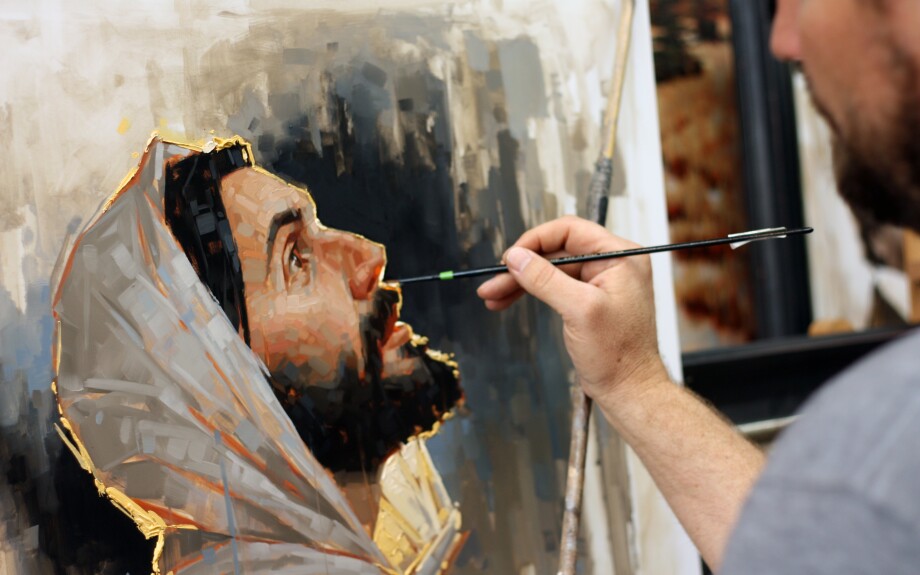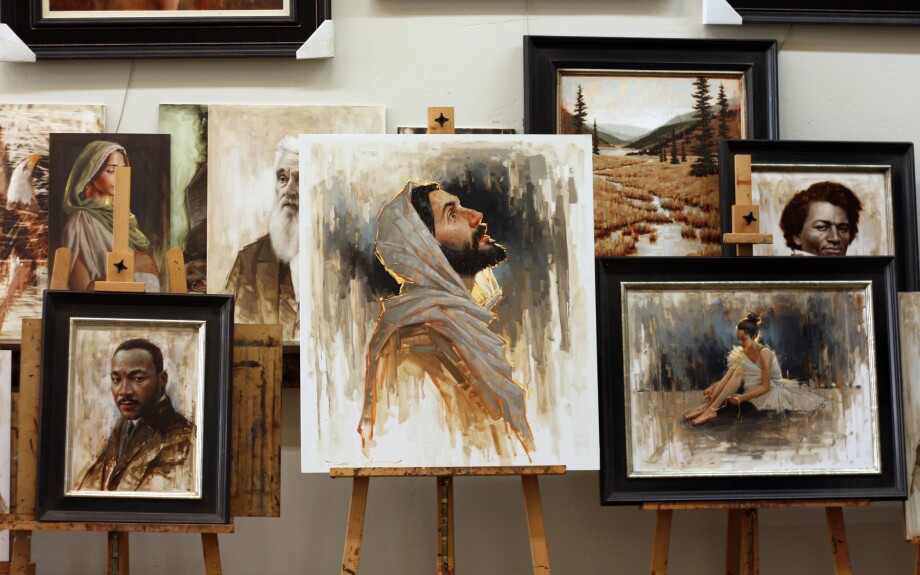Dan Wilson was working on the project of a lifetime: a massive 12-by-8-foot painting of Jesus descending from heaven in a cloud of majesty, flanked by more than 300 white-clad angels announcing the Second Coming with voice and trumpet.
The clouds had given him more trouble than they should have—in one corner the paint kept drying into a muddy brown instead of white, despite days of painting and repainting. “You’d think that the clouds would have been the easiest part!” Wilson recalls. Thankfully, after a desperate prayer for help, the clouds had finally come out properly—milky and featherlike.

The painting had been commissioned to hang in the Washington D.C. Temple—one of the Church's largest—after major renovations were completed, so for Wilson the stakes felt sky high.
But the piece was now coming together as he brushed the final touches onto Jesus’s robes, using vivid cadmium red and orange to add highlights where the sun shone through the crimson fabric. Setting down his brush, he left his studio for a quick lunch and forgot to lock the door behind him.
When he returned, Wilson heard tiny voices giggling in his studio. Rushing in, he found his 3-year-old son and 2-year-old daughter gleefully stroking cadmium red and orange onto the painting. “They were like, ‘This is fine,’” Wilson recalls. “‘Dad does it. Why can’t I? I’m just helping him out!’”
The toddlers were too short to reach most of the canvas, but their unwelcome additions were right on the low clouds that Wilson had finally perfected with great effort.
Wilson felt panic erupt in his chest but took the situation in stride. “I tend to smile and laugh when there’s nothing else you can do,” Wilson says. “But I literally—kind of with a smile on my face—yelled, ‘Aargh!’ I think I had a decent laugh over it, like, ‘You freaking punks. I can’t believe this!’”
Wilson shooed the youngsters out of the room and surveyed the damage with trepidation. The children had used some of the brightest paints on their father’s palette. “I didn’t know, because of the intensity of the color, if it was going to leave a stain,” Wilson remembers.
As he scraped at the vivid brushstrokes and massaged them with a solvent-soaked rag, Wilson contemplated something profound. “I just thought, … ‘I’m trying to create this masterpiece, and I’m failing at it constantly. But all of us are trying to create masterpieces with our life,’” he says, noting that just as with painting, our lives inevitably become marred with sins or mistakes that can be fixed.
Mercifully, the children’s fresh brushstrokes came out. “It was really cool to take turpentine and scrape those big mistakes away like they never even happened. It is so symbolic of the Atonement of Jesus Christ. No one’s living the masterpiece life like He did. But because He lived His masterpiece life, we can get rid of all the mistakes, the … sins. We can just erase it, as if it never even happened.”
An Angelic Throng
After the Second Coming painting, titled His Return, was fixed and finishing touches were completed, it was framed in gold and installed in the rotunda of the Washington D.C. Temple. Now, as visitors pass the recommend desk and traverse the walkway to the rotunda, their eyes can’t help but be drawn to Wilson’s enormous painting at the end of the corridor. Photos and videos from CBS News and Church Newsroom demonstrate the painting’s prominence at the temple’s entry.
Viewers will first note Jesus Christ as the central figure of the painting, but next the eye is drawn to the throng of more than 300 angels stretching into the distance. It was important to Wilson that people from diverse backgrounds be able to see at least one figure in the painting that looks like them, so the angels represent a diverse set of ethnicities, including Black, Asian, Polynesian, and Latino. But the sheer number of figures was daunting to depict.
“The complexity of a human figure is the hardest thing to paint in the universe,” Wilson says. “You throw another figure in there, and the complexity goes way up … because they all have to match up perfectly. When you’re dealing with 300 angels that have to perfectly go back into the atmosphere so that they’re not disrupting the main image of Christ—it was very hard.”
Including so many ethnically diverse figures presented a specific technical challenge, because Wilson needed to clearly show skin tones and facial features. But there was a drawback to this approach. “I had to include a lot of detail,” Wilson says, “but because of that detail, … [the angels] were advancing—they were coming forward at the viewer.” To keep the focus on Christ and to give the illusion that the angels were in the distance, the angels’ details needed to be less sharp.
Wilson knew that the solution was to “glaze down” the angels—a process where white translucent paint is applied to parts of the painting to mute color and detail.
“It’s very scary when I had put hundreds and hundreds of hours into painting these angels. The thought of messing up a glaze and having to redo all of that—I just didn’t have the time for it. I couldn’t redo everything,” Wilson says. “So I really couldn’t mess up this glaze.”
So he turned to heaven for help. “I was keeping that in my fast, and I was praying about it. And it was really cool because one morning, really early—like 4:30 in the morning—I pop out of bed, and in my mind’s eye I could see myself glazing the angels with a very specific lead white that is very transparent. And I saw the brush that I should use, and I knew the exact paint that I should use. And it just worked out perfectly,” Wilson recalls.
“Images of Christ That [People] Relate With”
With the angels properly fading into the background, the figure of Jesus Christ now maintains its prominence in the painting. For Wilson, he wants all his depictions of the Savior to leave an impact on the viewer, which is why he’s so deliberate when choosing models for his portraits of Jesus. He currently uses one of nine different men for each depiction, but many people are eager to help him expand his pool of models.
“It’s funny, people are always sending me images of [their] uncle, [their] husband, [or their] son: ‘He’s got long hair with a part in the middle, he has a beard, he’d be … perfect!’ And 99 percent would just not be good Jesus models.”
So what makes a great model for his paintings? “It is 100 percent about kind eyes,” he says. “You can paint in a beard, you can put in the hair, but you can’t fake the eyes.”
He also does his best to depict the Savior authentically in terms of ethnicity, which can be tricky to balance. One of his models is of authentically Middle Eastern descent, and yet a few viewers sometimes still feel that Wilson’s paintings miss the mark in how they depict Christ.
“It does not matter how [authentic] you get with your model. You will always have people say, ‘Go darker skinned.’” Other people prefer lighter skin, and Wilson suspects that most people tend to envision a Jesus who looks similar to them.
“There are a lot of question marks—exactly what were His skin tones? How dark was His hair? How long was His hair? What color were His eyes?” Wilson says. But for him, these questions aren’t primary and can never be answered with certainty. “I think it is most important that people [see] images of Christ that they relate with—and if that’s a Black Jesus, awesome. If it’s a lighter-skinned Jesus, great. I think it really matters that we just remember Him and try to be more like Him.”
Mari Oto, a member of Wilson’s ward who posed as an angel for the Second Coming painting, says that representation is important for Latter-day Saints from varied backgrounds. Oto, whose heritage is Chinese, Japanese, Hawaiian, and Portuguese, says she appreciates seeing diverse art in the Church, since it can be easier to relate to Deity, for example, when they resemble oneself.
“I’ve realized, ‘You know what? My God is actually Asian,’” Oto says. “I have a very clear image in my head of what my God looks like. And he’s like an Asian grandfather. … So I love being in Dan’s painting for the pure fact [that] representation matters. It does. It’s important for my kids to see someone that looks like them … within Church art.”
▶ You may also like: New, ethnically diverse temple artwork reflects global Church membership
Why Jesus Christ?
Wilson has painted Abraham Lincoln, Martin Luther King Jr., King David, and countless others. But his most-painted subject by far is Jesus Christ—he’s painted the Savior more than 500 times in the last decade. It took some time, though, for him to realize that this was the type of art he wanted to create.
After receiving his art degree from Utah Valley University, Wilson was mentored by the late William Whitaker, a painter who has been called “one of the most respected figurative artists in the country.” Many of Whitaker’s paintings, including portraits of Church leaders, are familiar to Latter-day Saints.
Whitaker was a master of technique, says Wilson. “All of his training was very technical. You had to have perfect colors, values, edges, shapes—everything was technical.” This training naturally caused Wilson to anticipate becoming a gallery artist depicting secular subjects. “But [then] I ended up painting my first serious image of Christ,” he says.
When members of his ward saw the painting, they asked to buy prints. “So I was going to Costco and printing these off,” Wilson says. The recipient of one of those ad-hoc prints stopped Wilson in the hallway at church one Sunday. “She said, ‘Dan, you have no idea what this image of Christ is doing for our family. … It just lights up our home,’” he recalls.
“And then the following week—in the exact same spot in that hallway at church—a sister came up and said, almost verbatim, the same words. ‘Dan,’ she said, ‘I gave your painting to my sister. Their family’s trying not to go through a divorce right now.’ And then she started crying and said, ‘You have no idea how much that is helping their family and lifting them up in their home,’” Wilson says.
“And when that happened, the light bulb just went off. I just knew I was supposed to be painting images of Christ and lift people up in their homes.”
Wilson has painted hundreds of portraits of Christ since that day, allowing countless others to feel a deeper connection to the Savior. Hannah Miller, former temple art curator for the Church, sees a rare skill in his art. “Without being saccharin or garish, he often portrays the Savior with tenderness and calm,” she says. “His paintings … speak of his sincere relationship with Christ that I think other people can feel and relate to.”
Today, Wilson continues to paint with the precision he learned from his mentor, but now his priority is something he feels is more crucial. “I still pay close attention to the technical aspect of painting,” he says. “But I’m now always asking myself, … ‘What am I communicating? How is this going to help the individual that has this in their home?’ And that has changed my career.” That shift, Wilson says, “has made everything just way more fun, way more fulfilling.”
Mari Oto has seen how Wilson’s art reflects the convictions of the artist: “He just lives his testimony. That shines through in his art and is evidenced in his character as well.”
His Return
Wilson’s art now inspires temple-goers the world over, with original paintings in temples like Lisbon, Oakland, and Orlando.
“Dan has several original paintings in … temples around the world, all of which are reproduced in many other temples,” says Miller. “He was chosen for this commission in DC because of his incredible tact in depicting the Savior. When people enter the temple, our hope was for them to feel welcomed by the Savior, and we are pleased that Dan has been able to accomplish that so well.”
For Oto, being depicted as an angel in His Return has been a fun experience, but it’s also led to some deeper reflection. Seeing herself helping usher in the Second Coming has made her consider whether she’d be ready when the Savior returns. “I feel a level of gratitude for the opportunity, and also a level of responsibility to more fully live my covenants,” she says.
And that’s just the type of reflection that Wilson wants this painting—and all his art—to inspire.
“I hope that when people see this, it connects with them in a real way. … When someone is standing in front of this painting, [because it’s a] life-size image, I want it to hit them on a new level,” he says. “And just a spark that, ‘Oh my gosh, this is going to happen. Am I preparing for this scene to happen? … Can I see myself as one of those angels helping to usher in the Second Coming?’…
“I hope that members, when they see this, go home motivated—feeling like, ‘Hey, I want to be a part of preparing the world for this scene.’
See more of Dan Wilson’s art on his website and at deseretbook.com














